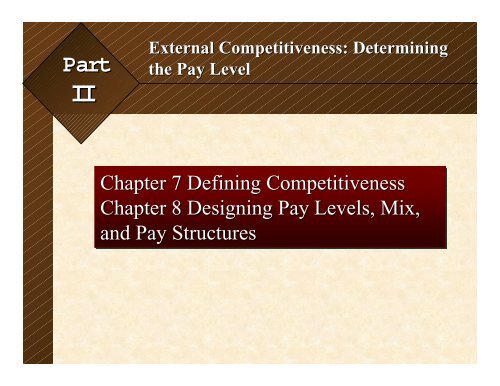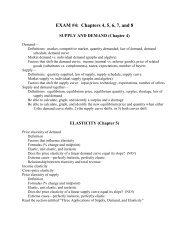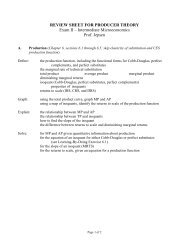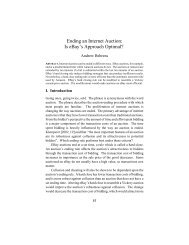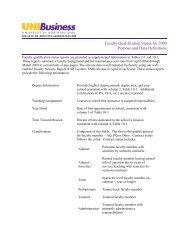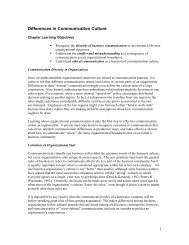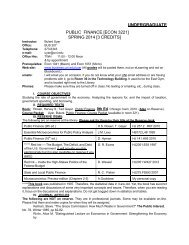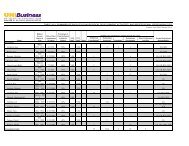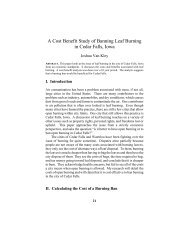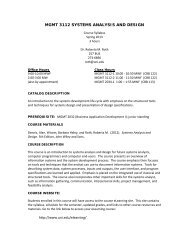Chapter 7 -- Defining competitiveness - College of Business ...
Chapter 7 -- Defining competitiveness - College of Business ...
Chapter 7 -- Defining competitiveness - College of Business ...
You also want an ePaper? Increase the reach of your titles
YUMPU automatically turns print PDFs into web optimized ePapers that Google loves.
Part<br />
II<br />
External Competitiveness: Determining<br />
the Pay Level<br />
7 - 1<br />
<strong>Chapter</strong> 7 <strong>Defining</strong> Competitiveness<br />
<strong>Chapter</strong> 8 Designing Pay Levels, Mix,<br />
and Pay Structures<br />
McGraw-Hill/Irwin<br />
© 2002 by The McGraw-Hill Companies, Inc. All rights reserved.
7 - 2<br />
STRATEGIC<br />
POLICIES<br />
TECHNIQUES<br />
STRATEGIC<br />
OBJECTIVES<br />
ALIGNMENT<br />
COMPETITIVENESS<br />
CONTRIBUTORS<br />
Work Descriptions Evaluation/ INTERNAL<br />
Analysis Certification STRUCTURE<br />
Market Surveys Policy PAY<br />
Definitions Lines STRUCTURE<br />
Seniority Performance Merit INCENTIVE<br />
Based Based Guidelines PROGRAMS<br />
EFFICIENCY<br />
• Performance<br />
• Quality<br />
• Customers<br />
• Stockholders<br />
• Costs<br />
FAIRNESS<br />
COMPLIANCE<br />
ADMINISTRATION<br />
Planning Budgeting Communication EVALUATION<br />
McGraw-Hill/Irwin<br />
© 2002 by The McGraw-Hill Companies, Inc. All rights reserved.
7 - 3<br />
<strong>Chapter</strong><br />
7<br />
<strong>Defining</strong> Competitiveness<br />
McGraw-Hill/Irwin<br />
© 2002 by The McGraw-Hill Companies, Inc. All rights reserved.
Learning Objectives<br />
After studying <strong>Chapter</strong> 7, students should be able to:<br />
1. Explain the importance <strong>of</strong> external<br />
<strong>competitiveness</strong> to the pay model.<br />
2. Discuss the factors that influence external<br />
<strong>competitiveness</strong>.<br />
3. Discuss the difference between labor market,<br />
product market, and organizational factors in<br />
determining external <strong>competitiveness</strong>.<br />
4. Explain the different pay policy decisions and<br />
the consequences <strong>of</strong> using each.<br />
7 - 4<br />
McGraw-Hill/Irwin<br />
© 2002 by The McGraw-Hill Companies, Inc. All rights reserved.
7 - 5<br />
External <strong>competitiveness</strong><br />
External <strong>competitiveness</strong><br />
refers to the pay relationships<br />
among organizations - the<br />
organization’s pay relative to its<br />
competitors.<br />
McGraw-Hill/Irwin<br />
© 2002 by The McGraw-Hill Companies, Inc. All rights reserved.
7 - 6<br />
External <strong>competitiveness</strong> is expressed in<br />
practice by:<br />
1. setting a pay level that is above,<br />
below, or equal to competitors, and<br />
2. by considering the mix <strong>of</strong> pay forms<br />
relative to those <strong>of</strong> competitors.<br />
McGraw-Hill/Irwin<br />
© 2002 by The McGraw-Hill Companies, Inc. All rights reserved.
7 - 7<br />
Pay level refers to the average <strong>of</strong> the array <strong>of</strong><br />
rates paid by an employer.<br />
Σ Base + Bonuses + Benefits + Options / Σ Employees<br />
Pay forms Pay forms refer to the mix <strong>of</strong> the various types <strong>of</strong><br />
payments that make up total compensation.<br />
McGraw-Hill/Irwin<br />
© 2002 by The McGraw-Hill Companies, Inc. All rights reserved.
7 - 8<br />
Pay level and mix focus attention<br />
on two objectives:<br />
Control Labor Costs<br />
Attract and Retain<br />
Employees<br />
McGraw-Hill/Irwin<br />
© 2002 by The McGraw-Hill Companies, Inc. All rights reserved.
7 - 9<br />
Pay Level Decisions Impact Labor Costs<br />
Labor Costs<br />
Number <strong>of</strong><br />
Employees<br />
= x<br />
Pay Level<br />
McGraw-Hill/Irwin<br />
© 2002 by The McGraw-Hill Companies, Inc. All rights reserved.
What Shapes External Competitiveness?<br />
LABOR MARKET FACTORS<br />
Nature <strong>of</strong> Demand<br />
Nature <strong>of</strong> Supply<br />
7 - 10<br />
PRODUCT MARKET FACTORS<br />
Degree <strong>of</strong> Competition<br />
Level <strong>of</strong> Product Demand<br />
EXTERNAL<br />
COMPETITIVENESS<br />
ORGANIZATION FACTORS<br />
Industry, Strategy, Size<br />
Individual Manager<br />
McGraw-Hill/Irwin<br />
© 2002 by The McGraw-Hill Companies, Inc. All rights reserved.
7 - 11<br />
Labor Demand<br />
! The marginal product <strong>of</strong> labor is the additional<br />
output associated with the employment <strong>of</strong> one<br />
additional human resource unit, with other<br />
production factors held constant.<br />
! The marginal revenue <strong>of</strong> labor is the additional<br />
revenue generated when the firm employs one<br />
additional unit <strong>of</strong> human resources, with other<br />
production factors held constant.<br />
McGraw-Hill/Irwin<br />
© 2002 by The McGraw-Hill Companies, Inc. All rights reserved.
Supply and Demand at the Market and Individual<br />
Employer Level<br />
7 - 12<br />
Market level<br />
Employer level<br />
$100,000 $100,000<br />
Pay for business graduates<br />
$50,000<br />
Demand Demand<br />
Supply Supply<br />
Pay for business graduates<br />
$50,000<br />
Marginal Marginal revenue revenue<br />
product product<br />
Supply to<br />
individual<br />
employer<br />
$25,000<br />
$25,000<br />
0 5 10 15 20 25<br />
Number <strong>of</strong> business graduates available<br />
Number <strong>of</strong> business graduates available<br />
McGraw-Hill/Irwin<br />
© 2002 by The McGraw-Hill Companies, Inc. All rights reserved.
7 - 13<br />
Labor Demand Theories and Implications<br />
Theory Prediction<br />
So What?<br />
Compensating<br />
differentials<br />
Efficiency wage<br />
Signaling<br />
Work with negative<br />
characteristics requires higher<br />
pay to attract workers.<br />
Above-market wages will improve<br />
efficiency by attracting workers<br />
who will perform better and be<br />
less willing to leave.<br />
Pay policies signal the kinds <strong>of</strong><br />
behavior the employer seeks.<br />
Job evaluation must collect<br />
and compensable factors<br />
most capture these negative<br />
characteristics.<br />
Staffing programs must have<br />
the capability <strong>of</strong> selecting the<br />
best employees. Work must<br />
be structured to take<br />
advantage <strong>of</strong> employees’<br />
greater efforts.<br />
Pay practices must recognize<br />
these behaviors by better pay,<br />
larger bonuses, and other<br />
forms <strong>of</strong> compensation.<br />
McGraw-Hill/Irwin<br />
© 2002 by The McGraw-Hill Companies, Inc. All rights reserved.
Labor Supply Theories and Implications<br />
7 - 14<br />
Theory<br />
Reservation wage<br />
Human capital<br />
Job competition<br />
Prediction<br />
Job seekers won’t accept jobs<br />
whose pay is below a certain<br />
wage, no matter how attractive<br />
other job aspects.<br />
The value <strong>of</strong> an individual’s skills<br />
and abilities is a function <strong>of</strong> the<br />
time and expense required to<br />
acquire them.<br />
Workers compete through<br />
qualifications for jobs with<br />
established wages.<br />
So What?<br />
Pay level will affect ability to<br />
recruit.<br />
Higher pay is required to<br />
induce people to train for<br />
more difficult jobs.<br />
As hiring difficulties increase,<br />
employers should expect to<br />
spend more to train new hires.<br />
McGraw-Hill/Irwin<br />
© 2002 by The McGraw-Hill Companies, Inc. All rights reserved.
Competitive Pay Policy Alternatives<br />
7 - 15<br />
Pay with Competition<br />
(Match)<br />
Lead Policy<br />
Lag Policy<br />
Flexible Policies<br />
Shared Choice<br />
Employer <strong>of</strong> Choice<br />
McGraw-Hill/Irwin<br />
© 2002 by The McGraw-Hill Companies, Inc. All rights reserved.
Pay Mix Policy Alternatives<br />
7 - 16<br />
Performance - Driven<br />
Market Match<br />
Options<br />
16%<br />
Benefits<br />
17%<br />
Base 50%<br />
Options 4%<br />
Bonus 6%<br />
Benefits<br />
20%<br />
Base 70%<br />
Bonus<br />
17%<br />
Options<br />
10%<br />
Work - Life Balance<br />
Benefits<br />
30%<br />
Bonus<br />
10%<br />
McGraw-Hill/Irwin<br />
Base 50%<br />
Security (Commitment)<br />
Benefits<br />
20%<br />
Base 80%<br />
© 2002 by The McGraw-Hill Companies, Inc. All rights reserved.
Some Consequences <strong>of</strong> Pay Levels<br />
7 - 17<br />
Contain operating<br />
expenses (labor costs)<br />
Increase pool <strong>of</strong><br />
qualified applicants<br />
Competitiveness <strong>of</strong> total<br />
compensation<br />
Increase quality and<br />
experience<br />
Reduce voluntary<br />
turnover<br />
McGraw-Hill/Irwin<br />
Reduce pay-related<br />
work stoppages<br />
Increase probability <strong>of</strong><br />
union-free status<br />
© 2002 by The McGraw-Hill Companies, Inc. All rights reserved.
Summary<br />
! There is no “going rate,” thus managers make conscious<br />
pay level and mix decisions influenced by several<br />
factors.<br />
! There are both product market and labor market factors<br />
that impact the pay level and mix decisions.<br />
! Alternative pay level and mix decisions have different<br />
consequences.<br />
! Pay policies need to be designed to achieve specific pay<br />
objectives.<br />
! To achieve the objectives stipulated for the pay system,<br />
both the pay level and mix must be properly positioned<br />
relative to competitors.<br />
7 - 18<br />
McGraw-Hill/Irwin<br />
© 2002 by The McGraw-Hill Companies, Inc. All rights reserved.
7 - 19<br />
Review Questions<br />
1. Distinguish policies on external <strong>competitiveness</strong><br />
from policies on internal alignment. Why is<br />
external <strong>competitiveness</strong> so important?<br />
2. What factors shape an organization’s external<br />
<strong>competitiveness</strong>?<br />
3. What does marginal revenue product have to do<br />
with pay?<br />
4. What pay level does the efficiency wage theory<br />
predict? Does the theory accurately predict<br />
organization behavior? Why or why not?<br />
McGraw-Hill/Irwin<br />
© 2002 by The McGraw-Hill Companies, Inc. All rights reserved.
7 - 20<br />
Review Questions (continued)<br />
5. What is a relevant market? What difference does it<br />
make when determining people’s pay?<br />
6. Can you think <strong>of</strong> any companies that follow a lag<br />
and/or lead policy? Why do they believe it pays to<br />
pay differently? Can you think <strong>of</strong> any companies<br />
that follow performance-driven and/or work-life<br />
balance policies?<br />
McGraw-Hill/Irwin<br />
© 2002 by The McGraw-Hill Companies, Inc. All rights reserved.


